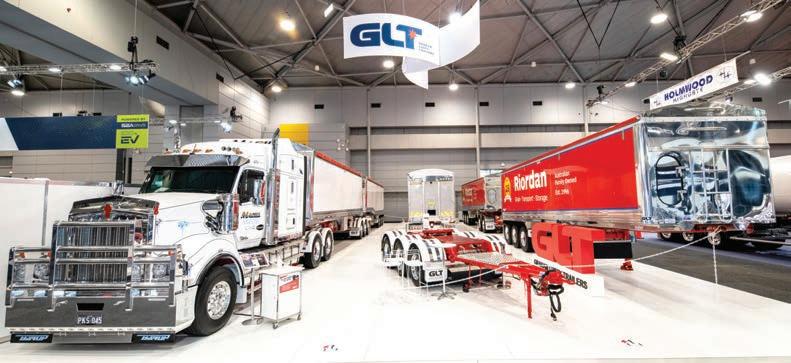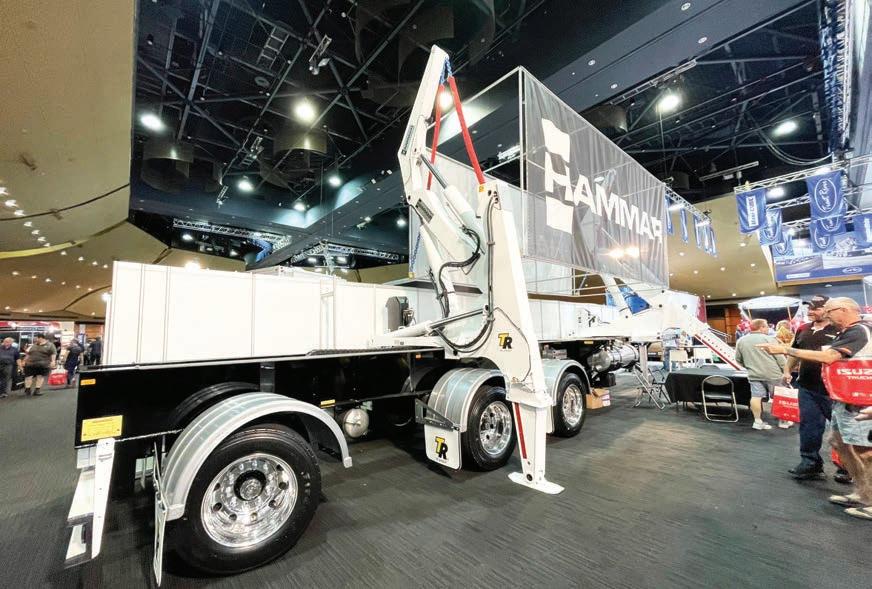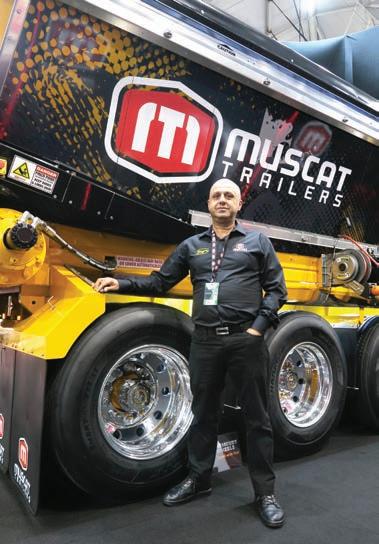
11 minute read
ALONG THE TRAILER TRAIL
A truck show has to have trucks. But, trailers are just as important. Australia is home to some of the best and toughest trailer manufacturers in the world. The Owner//Driver team follows the trailer trail at the Brisbane Truck Show
BYRNE’S BIG ON LIVESTOCK
Byrne Trailers showcased a diverse line-up at the Brisbane Truck Show (BTS) but the standouts were undoubtedly the livestock trailers, standing tall as the only ones on show. And with good reason.
The company, founded by Mick and Teri Byrne in Peak Hill, NSW, in 1974, has seen solid growth from its small beginnings, where it now claims to hold market leadership in the livestock sector.
Extensive manufacturing facilities were established in Wagga Wagga in 1988, with expansion into Queensland in 1993 via a manufacturing and service depot in Toowoomba.
Byrne’s capabilities were represented at the show via a B-triple unit that can cart sheep, cattle and pigs alongside a B-double cattle-only unit belonging to Shanahan’s Livestock Transport.
Though not outright new releases, Byrne explains it is seeing success in recent years with these units due to their clever stainless steel design, which delivers the “same strength and ductility as carbon steel but is 250 times more corrosion resistant”, and therefore “rusts 250 times slower”.
“It also makes the trailer a bit lighter and allows you to add a couple more animals on the trailer,” Byrne sales expert Sam Gwynne tells us.
A tri-axle dolly, designed for the livestock task, accompanied its headline units.
Elsewhere, Byrne had a couple of aluminium bulk trailers on display, containing the Keith Manufacturing Walking Floor conveying system, where slats move back and forth in the loading/unloading process.
One of units is ideal for agriculture, while the other, heavier-duty, unit, has been designed for waste and building supplies industries.

INNOVATIVE DRAKE
BTS saw some of the latest Drake Group innovations across the Drake Trailers and O’Phee Trailers brands.
The Drake Group show stand highlighted the fact it is still innovating, merging new technology with a century of combined O’Phee and Drake trailer-building know-how.
You’d be hard pressed walking through the show and missing the Drake Group’s gargantuan Steerable Deck Widener.
The latest widener from Drake features its own ‘Active Steer’, allowing for up to an additional 35 degrees of manoeuvrability – the difference between being able to fit or not!
A standout feature on the latest Steerable Deck Widener, and one of the keys to achieving such significant manoeuvrability improvements, is that all axles on the trailer steer, not just the self-tracking on the rear axle.
The system works via a mechanical link and is steered off the skid plate to the turntable, steering the trailer behind the prime mover.
Active Steer also allows the operator to steer the trailer independently using a remote control setup, allowing the trailer to be ‘crabbed’ to achieve more steering angle than you could with the prime mover.
O’Phee Trailers are all about semitrailers and its BTS display was all about showcasing performance-based



standards (PBS) Super Semi options. The O’Phee Super Semi range includes side loader, flat top, drop deck and skel trailers ranges.
The two on display at the show were the slick flat top and container skel trailers, showing off the new axle group arrangement that allows up to 49.5 tonnes gross in PBS applications.
GRAHAM LUSTY TRAILERS’ PBS OFFERING
It may not be all that widely known but Graham Lusty Trailers (GLT), listed as Lusty TIP Trailers Pty Ltd by parent company Teaminvest Private, is a big deal for said parent, which assumed full ownership just a couple of years ago.
After all, GLT “again delivered record operational and earnings improvements in the first half of the year” for TIP’s engineering division, TIP says.
“GLT’s unique designs deserve a substantial premium in the transport market, and their never-ending quest for innovation gives us confidence that their reputation as the ‘Rolls Royce’ of bulk haulage will continue to be enhanced,” it continues.
“Happily, the use of a GLT trailer adds so much to most haulage companies’ bottom line that customers now choose to place orders up to six months in advance just to secure a booking in GLT’s busy Brisbane facility.”
Such innovation was certainly on show, and taking pride of place was a 30-metre A-double combination with a tandem dolly setup for Riordan Grain Services.
Built for Victorian PBS applications, the combination comprises two chassis tippers, six-foot-six (1.98m)-high sides with 50-tonne hoists and manual rollover tarps.
“The combination all up can tare a payload of 68 tonne, so you’re getting around a gross weight of 82 to 85 tonne, depending what you put on them,” purchasing officer Grant Platts says.
“Another trailer here for Reardon is a chassis tipper with 6-foot (1.83m)-high sides – it has a blower application in it pumping grain up in the silos for when an auger isn’t available.
“We’ve got quite a few of those and they seem to be a bit of a flavour combination.”
Also featuring was a tri-axle dolly for 30m A-double PBS combinations for New South Wales and Queensland – which can run in conjunction with B-doubles.
Such a B-double unit was also on display, pulled by Magill Transport’s Kenworth prime mover.
“It’s our most common sale – it gives you the versatility of carrying a different range of products in different applications,” Platts says.
ROBUK’S AUTISM AWARENESS
A fascinating narrative coming out of the BTS is the emergence of Hemmant-based Robuk Engineering – and its backstory, given its relation to GLT.
As operations manager Josh Petersen tells us, BTS was meant to be the company’s big unveiling.
Instead, the 11-month-old fledgling company is already snowed-under with orders.
“It was supposed to be our, ‘hey, we’re here’ moment but our build schedule is out until April next year,” says Petersen.
“If we had them in the backyard we could have sold eight sets this week.”
Petersen describes the company as less than a year old, but with more than 90 years’ experience building trailers.
It’s the brainchild of James Yerbury, interestingly the former managing director of GLT, who, along with Petersen and others in the Robuk team, departed GLT following its takeover.
Petersen is quite bullish on his firm’s trajectory, saying it drew from its experience making trailers at GLT and “made it better”.
“We offer the full range of trailers – anything that carts grain: side tippers, end tippers, tip-overs, sliders, rollbacks, tri-axles, tandem dollies.
“We can also do some pocket road trains, 19-metre B-doubles.”
To this point, the confidence is justified for the expanding Brisbane-based company.
“We started in a small little shed in Gympie and outgrew the shed,” Petersen says.
“The trailers we were building were 34-foot (10.36m) – we had to build a 36-footer (10.97m) and it wouldn’t fit in the shed, so we had to come to Brisbane.
“We were going to do one trailer a month and be sustainable with the small crew we had, but the demand


was ridiculous as soon as anyone found out what we were doing.
“They all wanted trailers from us and our production schedule is out nearly 12 months.”
On show were customer Duggan Bulk Haulage’s two identical dangerous goods-specified 32-foot (9.75m) lightweight aluminium tippers with six-foot-six sides, taring in at 6.6 tonnes, along with a tri-axle dolly.
In a nice touch, Duggan’s livery puts autism awareness in the spotlight.
“John Duggan is a big advocate for autism awareness,” Petersen says.
“He said to me: ‘That is the only thing that matters about it, I couldn’t give a shit if they didn’t work.’
“Obviously we care if they didn’t work, but yeah, we’re very proud to display it.”
HAMMAR FLIES SWEDISH FLAG

Hammar is the Swedish container transport specialist with a burgeoning Australian presence – in fact, it claims to produce over half of all new sideloaders to hit the road here.
While its headquarters, manufacturing, development and testing are based in Olsfors, since Bengt-Olof Hammar designed his first sideloader in 1974 his company has expanded to eight worldwide locations, including Australia, and has provided its products to more than 115 countries.
As Australian general manager Grahame Heap tells us, bluntly: “You can’t be the best if you don’t focus on one thing.”
Thus, Hammar’s Australian business was displaying one such thing – its latest PBS offering, the split-tri PBS, allowing 30-plus tonnes payload on the road.
Heap notes the new concept’s axle groupings allow for a PBS combination with higher payloads, which will appeal to the wharf cartage sector.
“This combination is already up and running in Queensland and is able to carry higher mass without impacting infrastructure,” the National Heavy Vehicle Regulator (NHVR) notes in its own BTS walkaround.
The key to Hammar’s offering down under, Heap adds, is a high-grade steel brought in from Sweden, with frames manufactured there but assembled in Australia, and some chassis manufactured here too.
“You can take a main product and tweak it to suit the country you are in,” he says on the local focus on quality.
He also emphasises the brand’s dedicated local support network.
“If something goes wrong for an operator we are never down for long.”
MAXITRANS BIG CELEBRATION
MaxiTrans is a staunch BTS supporter, invested fully in the belief of its wider importance for the industry.
Of course, the show coincided with celebration of the group’s Freighter brand notching up 75 years – just another indication of the extraordinary staying power of the nation’s peerless trailer-making sector.
“Fortunately for us, we had a customer function where we saw in excess of 300 people attend and celebrate with us and former staff members. And we had customers from all across the country, which was fantastic, and a couple from New Zealand,” NSW sales manager Glen Sharman says of an event the company sees as an acute indication of customer regard for the make.
With so many of its makes and models on display, he was loath to highlight particular items but felt a comparison of old and new was compelling.
“If there was a highlight, it was showing the old strap trailer that we had up high,” Sharman says.
“Show attendees had the opportunity to see what a trailer looked like in the 1950s, how it was and how it differed to now.
“We had it on a current trailer, a current drop-deck, and that allowed people to walk underneath to see the quality of the finish and build of the Freighter products.”
Otherwise, he did note a “safety mezz deck on a Freighter drop deck, new model suspension on the Boral Azmeb, and the new diesel-electric fridge on the MultiQuip Maxi-Cube”.
Sharman is full of praise for show organiser Heavy Vehicle Industry Australia’s (HVIA’s) steely resolve to make the event a success, despite Covid spot-fires in the lead-up.
“We had full confidence in the HVIA and followed suit,” he said.
“We put the show on and supported them 100 per cent and beyond. We had outside space as well as inside space. We asked for additional space [early on].
“For us, it was about being there for the industry and for our customers.
“We looked at contingency plans if there was a border closedown, as opposed to not going to the show.”
That included surveying its dealer network and other options to source equipment.
PRIME POSITION FOR MUSCAT
No stranger to awards and recognition of high achievement, Muscat Trailers was keen to make the most of its BTS opportunity and spruik its offerings’ productivity and safety accomplishments.
“Because business is now more focused on safety, we are focusing on non-tip solutions,” Muscat Trailers CEO Troy Azzopardi, bullish about his firm’s ability to punch above its weight, said.
“This is a PBS quad that with the right prime mover can give the operator 32.5 tonne payload.
“We’ve worked in the non-tip market now for five years. We are a leader in non-tip solutions. Other manufacturers are sitting on the fence to see how the industry evolves. But I feel that’s not a plan.”
Certainly, Azzopardi feels Muscat was in a rare and very forward position, both in the Show and more broadly.
“When you look at the next 10 years, things will certainly evolve but we’re five years into it and about to release a second live floor.”
The top half is manufactured in the US but Muscat has been working with the manufacturer to ‘Australian-ise’ that section.
“The next version of this will be better again and more suited for our roads and our conditions.”
As a smaller manufacturer, the company was conservative in its presence but happy to gain a strategic position on main floor.
While Azzopardi was critical of a few much larger firms with bigger budget withdrawing, it did allow operations like his to shine. And he was one of a number who welcomed federal support for exhibitions and exhibitors, despite the time entangles in attendant red tape.
And while he believes the attendance was fair under the circumstances, he reckons organiser HVIA will “have its hands full” fitting everyone in during the next show.
Muscat Trailers CEO Troy Azzopardi






